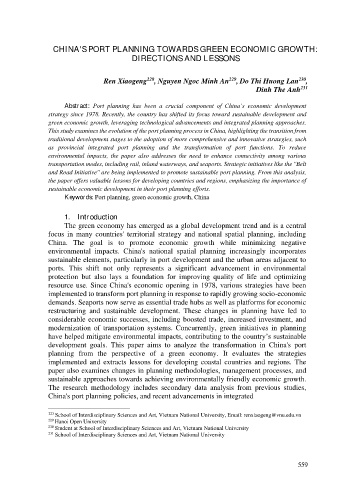Page 567 - Ebook HTKH 2024
P. 567
CHINA'S PORT PLANNING TOWARDS GREEN ECONOMIC GROWTH:
DIRECTIONS AND LESSONS
230
Ren Xiaogeng 228 , Nguyen Ngoc Minh An 229 , Do Thi Huong Lan ,
Dinh The Anh 231
Abstract: Port planning has been a crucial component of China’s economic development
strategy since 1978. Recently, the country has shifted its focus toward sustainable development and
green economic growth, leveraging technological advancements and integrated planning approaches.
This study examines the evolution of the port planning process in China, highlighting the transition from
traditional development stages to the adoption of more comprehensive and innovative strategies, such
as provincial integrated port planning and the transformation of port functions. To reduce
environmental impacts, the paper also addresses the need to enhance connectivity among various
transportation modes, including rail, inland waterways, and seaports. Strategic initiatives like the "Belt
and Road Initiative" are being implemented to promote sustainable port planning. From this analysis,
the paper offers valuable lessons for developing countries and regions, emphasizing the importance of
sustainable economic development in their port planning efforts.
Keywords: Port planning, green economic growth, China
1. Introduction
The green economy has emerged as a global development trend and is a central
focus in many countries' territorial strategy and national spatial planning, including
China. The goal is to promote economic growth while minimizing negative
environmental impacts. China's national spatial planning increasingly incorporates
sustainable elements, particularly in port development and the urban areas adjacent to
ports. This shift not only represents a significant advancement in environmental
protection but also lays a foundation for improving quality of life and optimizing
resource use. Since China's economic opening in 1978, various strategies have been
implemented to transform port planning in response to rapidly growing socio-economic
demands. Seaports now serve as essential trade hubs as well as platforms for economic
restructuring and sustainable development. These changes in planning have led to
considerable economic successes, including boosted trade, increased investment, and
modernization of transportation systems. Concurrently, green initiatives in planning
have helped mitigate environmental impacts, contributing to the country’s sustainable
development goals. This paper aims to analyze the transformation in China's port
planning from the perspective of a green economy. It evaluates the strategies
implemented and extracts lessons for developing coastal countries and regions. The
paper also examines changes in planning methodologies, management processes, and
sustainable approaches towards achieving environmentally friendly economic growth.
The research methodology includes secondary data analysis from previous studies,
China's port planning policies, and recent advancements in integrated
223 School of Interdisciplinary Sciences and Art, Vietnam National University, Email: renxiaogeng@vnu.edu.vn
229 Hanoi Open University
230 Student at School of Interdisciplinary Sciences and Art, Vietnam National University
231 School of Interdisciplinary Sciences and Art, Vietnam National University
559

